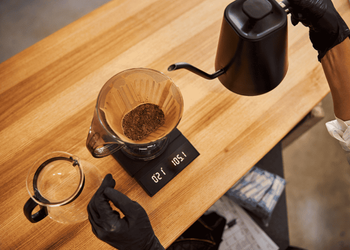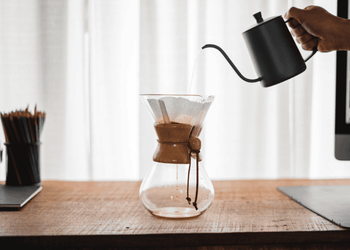
Cone vs Flat Basket Shape Coffee Filter: Which is Better?

In the world of coffee lovers, the choice of coffee filter shape isn't just a matter of preference; it's a fueled debate that influences the very essence of your morning cup.
Today, in this article I will spill the beans on this age-old question: Which is better between Cone and Flat basket shaped coffee filters?
Stay with me till the end as I unwrap these coffee equipment, their flavor implications, and the overall impact of these two filter shapes. It's not just a battle; it's a quest for the perfect brew that will make your morning ritual truly exceptional.
So, grab your favorite mug, and let the showdown begin!
Does the shape of the coffee filter matter?
Yes, the shape of your coffee filter matters a lot! It's not just a matter of aesthetics; it greatly influences the brewing process and, thus, the taste of your coffee.
The debate between cone and flat basket shape filters goes beyond personal preference, delving into extraction efficiency, flavor profiles, and even environmental considerations.
Overview of Cone coffee filters
What is a cone-shaped coffee filter?
A cone-shaped coffee filter is a coffee brewing equipment designed with a tapered, conical structure.
Made of paper, this filter style features a pointed bottom and a wider opening at the top, leading to a more focused water flow through the central point, ensuring a balanced and even extraction of flavors from the coffee grounds.
Adored for its unique shape and brighter, aromatic cup, this filter is a popular choice for enthusiasts enjoying a well-rounded flavor profile in their brew.
Advantages
1) Even extraction
The tapered shape facilitates an even and balanced extraction, ensuring that water flows through the central point, saturating coffee grounds uniformly.
2) Enhanced flavor profile
The focused extraction in a cone-shaped filter leads to a brighter and more aromatic flavor profile, letting the unique characteristics of the coffee beans shine.
3) Versatility
Cone filters are versatile and compatible with various coffee makers, making them a convenient choice for those who prefer flexibility in their brewing methods.
4) Reduced bitterness
This design minimizes over-extraction, resulting in a cup that is less bitter and more pleasant on the palate.
5) Space-efficient
The tapered design saves space and provides stability, making cone-shaped filters practical and easy to handle.
6) Customizable brew strength
Adjusting the grind size and drip rate allows to customize brew strength, giving users control over the intensity of their coffee.
7) Easy water flow
The conical shape allows for better control of water flow, preventing uneven saturation and ensuring a more consistent brewing experience.
8) Quick brewing
The tapered design accelerates the brewing process, providing a quicker route to a flavorful cup of coffee for those on the go.
Disadvantages
1) Uneven saturation
While it is efficient for smaller quantities, cone-shaped filters may lead to uneven saturation while brewing large batches, strongly impacting the flavor consistency across the brew.
2) Dependency on placement
Proper placement is crucial for cone filters. Incorrect positioning or folding can lead to water bypassing certain grounds, resulting in an uneven extraction and influencing the overall taste.
3) Limited surface area
While advantageous for focused extraction, it may restrict the overall surface area in contact with water, strongly affecting the extraction efficiency, especially when brewing larger quantities.
4) Potential for channeling
The pointed bottom of cone filters might contribute to channeling, where water follows the same path via the coffee grounds, potentially resulting in inconsistent extraction and flavor imbalance.
5) Compatibility issues
Cone filters may not be compatible with all coffee makers. Ensuring the right fit becomes vital, and some coffee makers might require specific adaptations for optimal use.
6) Risk of over-extraction
In situations where the brewing process is not carefully monitored, the focused extraction of cone filters may pose a risk of over-extraction, yielding a bitter or acidic taste in the coffee.
7) Cost considerations
These filters are somewhat expensive compared to their flat counterparts. The brand and material play a crucial role in impacting the overall cost.
Overview of basket shape flat coffee filters
What are flat coffee filters?
Flat coffee filters is a coffee brewing equipment that has a flat, rectangular shape and straightforward design.
Generally made of paper, these filters provide a spacious surface area for brewing, allowing water to completely interact with the coffee grounds.
Its flat design encourages an easier extraction process, coaxing out deep and rich flavors that create a warm and smooth coffee experience.
Advantages
1) Even saturation
No more bitter bites, just pure, smooth goodness that warms you from the inside out. The flat design ensures an even saturation of coffee grounds, promoting a consistent extraction process that contributes to a balanced and well-rounded cup.
2) Ease of brewing
The straightforward design of flat filters simplifies the brewing process, making them user-friendly and accessible to both beginners and other coffee enthusiasts.
3) Consistent flavor profile
Flat coffee filters contribute to a more consistent flavor profile, as the wide surface area promotes a uniform extraction, ensuring that each cup maintains a reliable and familiar taste.
4) Versatility
Due to their simple design, flat filters are versatile and compatible with various coffee makers and brewing methods, providing flexibility for different preferences.
5) Cost-effective
Often more budget-friendly than specialized filters, flat coffee filters offer a cost-effective solution for those who enjoy a quality brewing experience without breaking the bank.
6) Reduced risk of channeling
The flat surface minimizes the risk of water channeling through the coffee grounds, promoting a more uniform extraction and reducing the likelihood of uneven flavors in the cup.
Disadvantages
1) Potential for over-extraction
The expensive surface area may lead to over-extraction, particularly if brewing times and water volumes are not carefully monitored.
2) Challenging for smaller batches
Brewing smaller quantities with flat filters might pose a challenge, as the design optimized for larger surface areas results in less efficient extraction for minimal coffee doses.
3) Dependency on correct placement
Proper placement and alignment are crucial for flat filters. Misplacement can lead to uneven saturation and hinder the effectiveness of the brewing process.
4) Bulkier storage
Flat filters, due to their larger surface area, require more storage space in comparison to compact cone-shaped filters, potentially posing storage challenges, especially in smaller kitchens.
5) Possibility of flavor dilution
In certain brewing scenarios, the wide surface area may contribute to a quicker extraction, potentially leading to flavor dilution if not managed appropriately.
6) Less precision in pouring techniques
The simplicity of the flat design may limit the precision of pouring techniques compared to conical filters, potentially affecting the control over water distribution during brewing.
7) Less specialized for certain brews
For specific brewing styles that benefit from specialized filters, such as slow-drip methods, flat filters may not provide the same level of precision and control as their conical counterparts.
Cone vs Flat coffee filters: Quick comparison
1) Shape
Cone filters are tapered and conical in shape, directing water to a central point for even extraction. Flat filters are rectangular, providing a spacious surface area for water interaction with coffee grounds.
2) Compatibility
Cone Filters require specific coffee makers designed to accommodate the tapered shape. On the other side, flat filters are versatile, and compatible with various coffee makers due to their straightforward design.
3) Design
Cone filters focus on a pointed bottom for precise water flow and controlled extraction. Whereas flat filters offer a wide surface area, promoting even saturation and a more relaxed brewing process.
4) Contact time
Cone filters pose a shorter contact time between water and coffee grounds. Flat filters provide a longer contact time, allowing for a more thorough extraction of flavors.
5) Brew style
Cone filters are best for those who prefer a brighter, more aromatic cup with nuanced flavor notes. While for coffee lovers emphasizing deep flavors, flat filters are ideal.
6) Availability
When it comes to availability, cone filters are widely available, but the specific shape may vary between brands and models. Flat filters are universally accessible and easily available in most stores, offering convenience and easy replacement.
7) Material used
Cone filters are typically made of paper, ensuring efficient filtration and contributing to a brighter brew. While flat filters are commonly made of paper, providing ample space for water interaction and fostering a rich extraction process.
Cone shape filters or flat filters: How to choose the right filter?
1) Flavor preference
Opt for a conical filter if you prefer a brighter, more aromatic cup with pronounced flavor nuances. In case you wish for a rich flavor and a smoother taste profile go for a flat filter.
2) Brewing speed
If you value a quicker brewing process, the conical shape will aid you in facilitating a faster extraction due to its focused water flow. For those who appreciate a more leisurely brewing pace, flat filters provide a longer contact time between water and coffee grounds.
3) Brewing equipment compatibility
Consider conical filters if your coffee maker is designed to accommodate the tapered shape, ensuring a proper fit. While opting for flat filters if you desire versatility.
4) Space efficiency
Pick conical filters if you have limited space, as their compact design may be advantageous in smaller kitchens. Select flat filters if storage space is not a concern, as their larger surface area may require more room.
5) Ease of use
If simplicity is what you desire, conical filters are best with their user-friendliness and straightforward approach. It is suitable for both beginners and seasoned coffee enthusiasts. Select flat filters for an uncomplicated brewing process, providing ease of use and accessibility.
Summing it up
That's a wrap for this debate. I hope now you have a complete idea about both these coffee filters. I hope the next time a coffee lover friend asks you while choosing between both you can help them make the right choice.
Which team are you? TEAM CONE or TEAM FLAT.
Share your views in the comments. For more such coffee adventures, don't forget to subscribe to our YouTube channel or follow us on Instagram to stay updated with everything about coffee.
FAQs
1) What is the reason behind using a coffee filter?
Coffee grounds contain sediment, which can be gritty and unpleasant to drink. Coffee filters here act as barriers, trapping these grounds and delivering a clean, enjoyable cup.
2) What if you use a cone coffee filter in a flat-bottom coffee filter?
While not considered ideal, you can use a cone filter in a flat-bottom one in worst-case scenarios. Simply fold the cone lengthwise to create a flat base. You can expect uneven extraction and potential leakage here, but it can work for a single-use fix.

I am a barista by profession hailing from NC. My journey began in my late teens when I started working as a barista in a local coffee shop. My passion for coffee quickly became evident as I immersed myself in the art of espresso extraction, latte art ...



